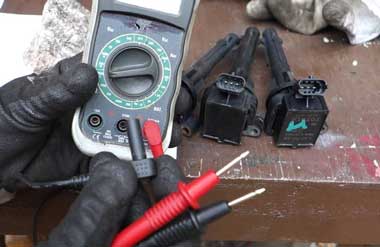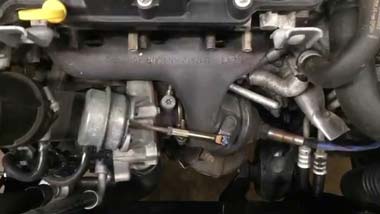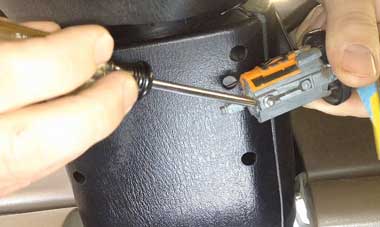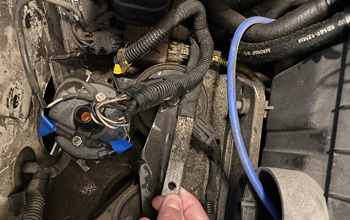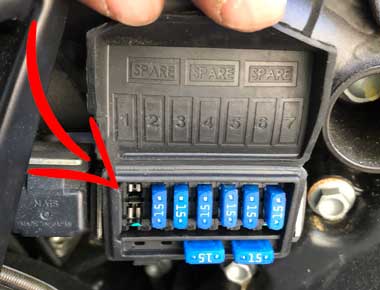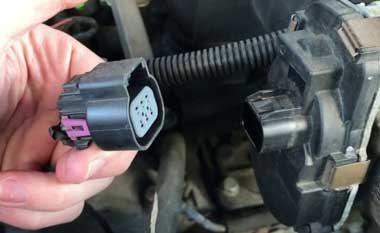Are Chevy Engine Misfires Frustrating You?
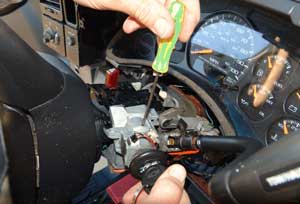
Are you seeing stabilink message, engine check light, P0300, or P0308, and you are wondering what’s happening? Or if your chevy engine is misfiring, look no further. In this article, we would mention the reason as well as what might be needed to get it fixed.
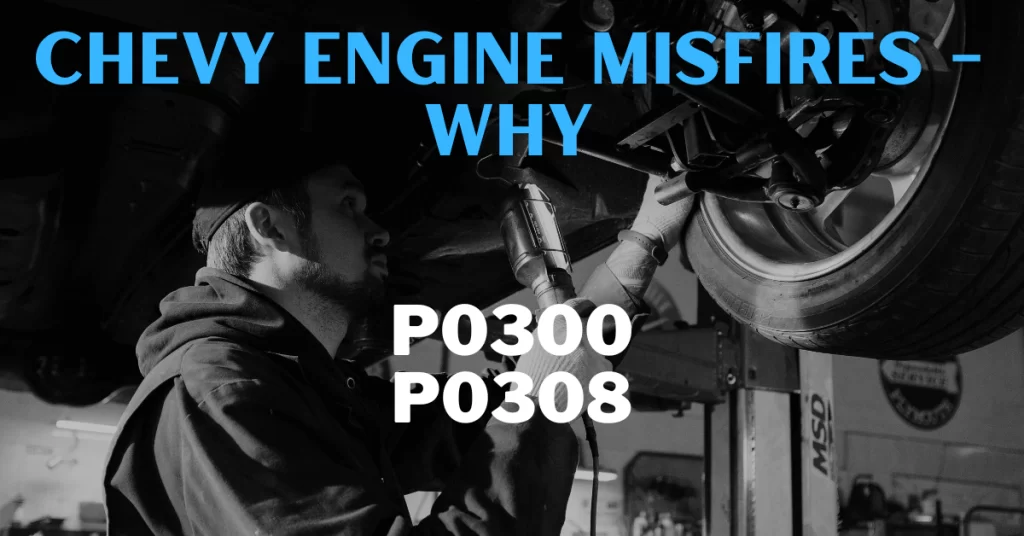
What is Engine Misfire symptoms-Chevy Engine Misfires
The error code P0300 or P0308 typically indicates a misfire in the engine cylinder.
It would start with a check engine light flashing, on visiting the dealership they would read the error code P0300. This error code denotes engine misfire. The engine would start idling or changing sounds. Other symptoms could be the engine not able to provide full acceleration, you will experience sluggish acceleration where your car fails to achieve top speed. In extreme cases, you may also observe black exhaust smoke.
What is P300 Error Code?
P300 error code as mentioned above as well, denotes engine misfire. P0308 means that the 8th cylinder of the engine is misfiring. Using the error code knowledge, the mechanic would also be able to diagnose which cylinder is misfiring.
What is a Misfire?
Put simply, a misfire is when the air/fuel mixture in your vehicle’s cylinders does not combust properly. Common symptoms of a misfire include rough idling, decreased power output, and increased emissions. Misfiring can be caused by anything from a faulty spark plug to a failed catalytic converter.
Engine Misfire causes
Many factors can be behind an engine misfire, from fuel to spark plug. In order to pinpoint the right root cause of misfiring, one would have to start with the most common cause of misfiring which is damaged spark plugs or spark wires and check if replacing those helps. One by one you can eliminate an find out the real cause. If you want to read more about spark plugs, you can explore this section in the website.
5 3 Vortec Misfire Problem No Codes
One of the more frustrating aspects of troubleshooting a 5.3 Vortec misfire is the need for diagnostic codes. The engine often will not set any codes that would help pinpoint the exact cause of the misfire. In these cases, it’s essential to perform a thorough visual inspection of the engine and components and look for any potential blockages or vacuum leaks.
Misfires on One Side of the Engine: What to Do
Once the source of the misfires is identified, the necessary fixes can be completed. Each cause will require a slightly different maintenance and repair process, so ensuring the fix is tailored to the exact issue is important.
Luckily, diagnosing and fixing misfires on one side of the engine is doable with patience and knowledge. Taking note of the symptoms and gathering the necessary information can go a long way in helping to find the source of the problem.
How Do I Test For A Misfire?
Here’s a step-by-step guide to testing for a misfire.
Step 1: Perform an initial visual inspection
If you see any obvious signs of damage, it’s best to have it inspected by a professional before attempting any more extensive testing.
Step 2: Perform a compression test
A compression test is often used to determine the condition of an engine’s cylinder head and valves. If the readings are lower than expected, it may indicate a misfire.
Step 3: Check the spark plugs
Remove the spark plugs and inspect each one for signs of excessive wear or damage. If the spark plugs appear in good condition, then a misfire might be caused by other issues.
Step 4: Take a look at the fuel injectors
Next, look at the fuel injectors and ensure the pressure is the same for each engine cylinder.
Step 5: Investigate the ignition system
Finally, look deeper into the ignition system to ensure everything functions correctly. Check the wiring, spark plugs, and other components to ensure they’re in good condition and not causing any issues.
Will Changing Spark Plugs Fix A Misfire?
Yes”. However, it is essential to note that the misfire is the symptom, not the underlying cause. To fully fix the problem, you will need to identify the real cause of the misfire and take the necessary steps to correct it.
What Sensors Can Cause Misfire?
Regarding engine misfires, the oxygen sensor is often a primary suspect. An oxygen sensor measures the air-to-fuel ratio in your engine, and if the ratio becomes off balance, it can cause the engine to misfire. It’s a small but essential part of your vehicle’s engine, and a faulty oxygen sensor can lead to significant performance issues.
Chevy Silverado Misfire Problem
Here are some of the most common causes of a Chevy Silverado misfire and some tips for resolving them.
- Faulty Spark Plugs: Faulty spark plugs are the most common cause of a misfire. This can be due to various issues, such as wear and tear, loose connections, or a failure in the wiring of the spark plugs themselves.
- Clogged Air Filters: An excessively clogged air filter is another potential cause of misfires.
- Faulty Ignition System: The ignition system could be to blame if the misfire is not happening due to the spark plugs or air filtration problems.
- Vacuum Leaks: Occasionally, a misfire in your Silverado may result from a leak in the vacuum system. This is usually caused by a loose connection or a hose that isn’t properly secured.
Misfire But No Check Engine Light
The most common cause of a misfire but no Check Engine Light is spark plug failure. This can happen from normal wear and tear over time or using poor-quality spark plugs that don’t have the required gap for the ignited fuel to form an effective flame front. When the spark plugs fail, not all of the cylinders ignite, which causes a misfire.
Can A Maf Sensor Cause A Misfire?
The answer is a resounding yes. MAF stands for Mass Air Flow, one of the most critical components in your internal combustion engine. The MAF senses the mass of air entering the engine, which it then uses to regulate the air/fuel ratio.
Can Changing O2 Sensor Cause Misfire?
The answer is a resounding yes. The Oxygen (O2) sensor is an important part of a vehicle’s engine and is critical in ensuring satisfactory operation and fuel efficiency.
Can Low Oil Cause Misfire?
Yes. If the oil level becomes too low, the engine no longer has enough lubrication to function properly. Without adequate lubrication, the engine’s moving parts – the pistons, valves, and others – will begin to grind and misfire.
How to Fix Engine Misfires?
Once the culprit has been identified, a simple solution in most cases for this error is to replace spark plugs and wires. This should solve your problem. Sometimes with an engine check light, you would also get a service stability message in the message center, which might also correspond to a similar problem. If you are facing an engine misfire with these symptoms, replacing spark plugs should solve your problem. Want to explore the best spark plugs for chery cruze, check it out here.
On rare occasions, you would have to deep dive further and explore other causes as well if even replacing the spark plugs doesn’t solve the error message. You can try swapping or replacing ignition coils or fuel injectors.
Here is a video guide on how to fix your Chevy Silverado P0300 error
Can a Misfire Fix Itself?
The answer is, maybe. Some misfires can simply be attributed to the fuel mixture in your car’s engine being off and the computer system in modern vehicles can sense this and automatically adjust the air/fuel ratio to ensure the engine runs more smoothly.
How To Help a Misfire Self-Correct
While you won’t be able to fix the underlying issue that is causing the misfire, there are some steps you can take to help the process along:
First, make sure your engine is receiving adequate fuel pressure. If you notice that the engine is having trouble running, check that the fuel pressure to the injectors is equal to the manufacturer’s specs.
Second, check the spark plugs. If the gaps on the spark plugs are too wide, this could also cause a misfire. Resetting the gaps to the correct specifications should help the misfire in question if not fully fixed.
Third, check your vehicle’s timing. A misfire can also be caused by camshaft timing, so ensure all timing components are properly set.
Finally, if you suspect that a faulty part may be causing the misfire, then you can use a code reader to check for any malfunction codes. If there is a specific code related to the misfire, you should take your vehicle to a qualified mechanic.
Will changing spark plugs fix a misfire?
Changing spark plugs can fix this problem as long as the plugs are in good condition and the connections to them are tight and properly engaged.
If the spark plugs are fouled or dirty, they can’t ignite the fuel properly, so switching them out with new ones could solve the misfire. However, if the spark plugs are in good condition, the misfire may be caused by something else entirely.
Can I drive with a misfire?
Yes, you can, but it’s not advised. If the misfire is relatively small, it’s possible to drive the car short distances, but it may cause further damage if it’s not taken care of promptly. The vibration, smoke, and lack of power can be particularly difficult to manage while driving, and the misfire could be a symptom of a much more serious problem.
Can too much oil cause misfire?
The answer is yes, it can. When there is too much oil in the engine cylinder, it affects the functioning of the spark plug. The spark plug ignites the fuel-air mixture, but if too much oil is present, it can cause the plug to become gummed up, preventing proper ignition. This effectively causes a misfire, impacting the engine’s operation.
Can a oil change fix a misfire?
Many people mistakenly believe that an oil change can cure their engine problems, but this is not the case. A misfire can be caused by various issues and is far too complex to fix simply by an oil change.
What type of misfire is most severe?
Regarding the most severe misfire, the type “A” misfire is at the top of the list. This type of misfire can occur when one or more of the cylinders in the engine environment fails to fire or partially fire. Various things, such as faulty spark plugs, worn spark plug wires, a dirty air filter, incorrect ignition timing, or a faulty fuel injector, can cause it. Unlike other misfires, type “A” misfires can cause the engine to misfire more than one cylinder at a time.
What sensors can cause misfires?
The most common sensors that can cause misfires in a car are the mass airflow and the oxygen sensor. These two components work together to measure the air entering the engine and the oxygen content of the air. If either of these sensors is not functioning correctly, then the engine can misfire and cause an improper fuel-air mixture.
What damage can a misfire cause?
One of the most common consequences of a misfire is engine damage. A gap develops between the spark plugs and the engine’s valves when a misfire occurs. This gap produces hot spots in the exhaust gases that can melt the engine’s metal components, causing permanent damage.
Another type of misfire occurring in an internal combustion engine is called an exhaust backfire. This occurs when the exhaust valve opens too late, or when the spark plugs fires too late.
Does misfire cause engine vibration?
In some cases, where a serious mechanical problem causes a misfire, this misfire can cause vibration. However, in most cases, the two are completely unrelated. Engine vibration can have a variety of causes and can be diagnosed using one’s car’s engine performance data.
Final thoughts on Are Chevy Engine Misfires Frustrating You?
As explained above, there could be multiple reasons behind an engine misfire. The misfires are usually caused by bad spark plugs or spark plug wires. Always start your troubleshooting by replacing the sparkplugs first.
Later on, if this solution does not solve your problem, look for advanced cases like swapping the ignition coils. If that also doesn’t help, try replacing the fuel injectors as well. At this stage your problems should have been resolved, however, if you are still stuck, you should approach a reputable mechanic or check out with your dealership.

